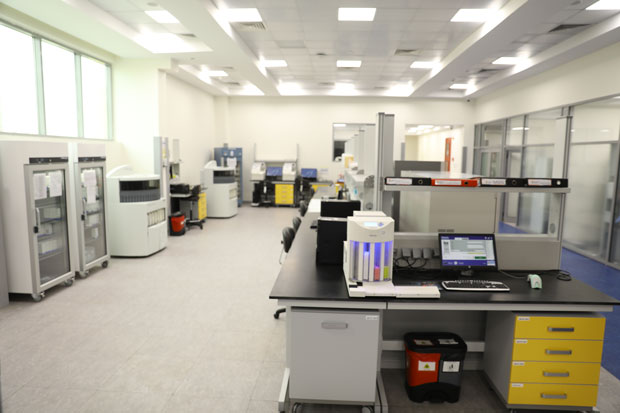BRAF Extended mutation panel

BRAF Extended Mutation Panel (V600E, V600K & V600R)
- Clinical Implications
- Melanoma
- BRAF mutation is the most common oncogenic driver in melanoma (~ 60%)
- Many BRAF fusions contribute to different responses to MAPK inhibition
- BRAF inhibitors
- Small molecule that binds mutated BRAF and renders protein inactivation
- FDA-approved inhibitors: Vemurafenib, dabrafenib, trametinib
- More than 70% of BRAF mutations are V600E and 10-30% are V600K. Potent and selective BRAF inhibitors have demonstrated significant clinical benefits in patients with V600E and V600K BRAF-mutated melanoma.
- V600R mutations constitute approximately 3-7% of all BRAF mutations.
- Test Description
- Test approach
- Reporting name
- Test prerequisites (To ensure timely results)
- Patient’s demographic data.
- Clinicopathologic information:
- Pathology report (final or preliminary) including anatomic location.
- History of any given therapy for cancer and its date and relation to sample sent for molecular study (i.e. pre & post therapy). Therapy includes chemo and radiotherapy, hormonal or targeted therapy.
- Any other relevant clinical data or history.
- Type of sample:
- Preferred: Formalin-fixed, paraffin-embedded (FFPE) tumor tissue block.
- Acceptable:
- Section in Eppendorf: Up to 4 sections, each with a thickness of up to 10 μm and a surface area of up to 250 mm2 + good H&E slide for assessment.
- Five unstained slides + one good H&E slide.
- Specimen Minimum Volume: Two 10-micron sections of FFPE.
- Quality Control measures
- From your side:
- Double check you are fulfilling all required data before sending your sample.
- Check that your pathologist has selected the best block in terms of tumor cellularity, with least presence of necrosis and inflammation.
- Pretherapy sample is preferred (if underwent any cancer therapy).
- In our lab:
- Assessment of tissue for adequacy & tumor cellularity before any molecular analysis.
- Matching block ID with the report ID and demographic data.
- Matching the submitted block with the data reported in the pathology report.
- N.B.
- If the sample sent in Eppendorf, it is your pathology lab’s responsibility to ensure the sample in Eppendorf is corresponding to the submitted H&E slide (we can’t prepare slide from Eppendorf).
- This test does not include a pathology consultation.
- Test Time
- Retention of the sample
- Selected References
- Turner JA et al: BRAF fusions identified in melanomas have variable treatment responses and phenotypes. Oncogene. ePub, 2018
- Ross JS et al: The distribution of BRAF gene fusions in solid tumors and response to targeted therapy. Int J Cancer. 138(4):881-90, 2016
- Aramini JM et al: The RAS-binding domain of human BRAF protein serine/threonine kinase exhibits allosteric conformational changes upon binding HRAS. Structure. 23(8):1382-93, 2015
Real-time PCR for quantitative detection of BRAF V600E, D, R and K mutations.
DNA was isolated and amplified by quantitative polymerase chain reaction (qPCR) using BRAF V600E, D, R and K CE-IVD kit. according to manufacture protocol. Results interpreted according to the manufacture user guide.
BRAF extended mutation panel
All samples are subject to stringent quality control measures that include:
From 3 days to 5 working days.
Client provided paraffin blocks & unstained slides (if provided) will be returned after testing is complete.